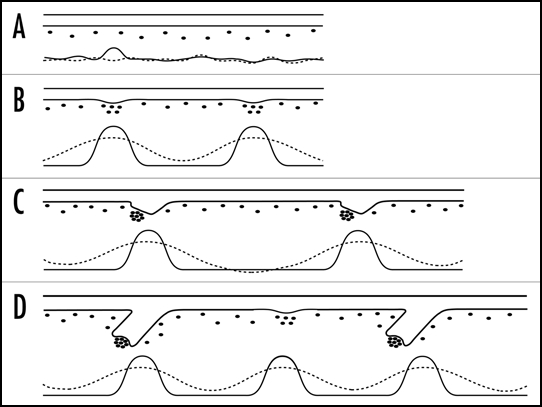Figure 1.

Schematic of early hair follicle development in mouse and the hypothesised distribution of WNTs and DKKs as the critical regulators of interfollicular spacing. According to the RD hypothesis of Alan Turing, patterning starts with an almost even distribution of activator and inhibitor (solid and dashed lines, respectively) (A, bottom). Transferring the model to murine hair follicle morphogenesis, this molecular pattern is associated with a morphologically unstructured epidermis (A, top); (the underlying dermis is indicated by black spots). Of note, WNTs and DKKs were recently suggested to represent an activator/inhibitor pair in follicle development. In the RD model, small fluctuations in the initially even protein distribution are enhanced and, eventually, give rise to a distinct and stable pattern of activator and inhibitor distribution (B, bottom). This is mainly achieved by an activator controlling expression of its own as well of the inhibitor, an inhibitor antagonising the activator's action, and an increased mobility of the inhibitor as compared to the activator. Although protein distribution in the developing skin is still hypothetical, the predicted pattern could control hair follicle morphogenesis, the first sign of which are epithelial thickenings (B, top). They stimulate the formation of dermal condensates which become dermal papillae later on. Of note, interfollicular spacing is solely determined by the parameters of the underlying RD mechanism. Hence, upon embryo growth, areas in between previously formed follicles again become capable of hair follicle formation owing to local protein levels (C). While the Turing model cannot describe this transitional state, it clearly predicts the formation of new follicles after enlargement of the interfollicular space (D); without changing the underlying parameters, the RD mechanism generates a fixed spacing pattern. Indeed, hair follicle development in mouse does occur by consecutive inductive waves.
